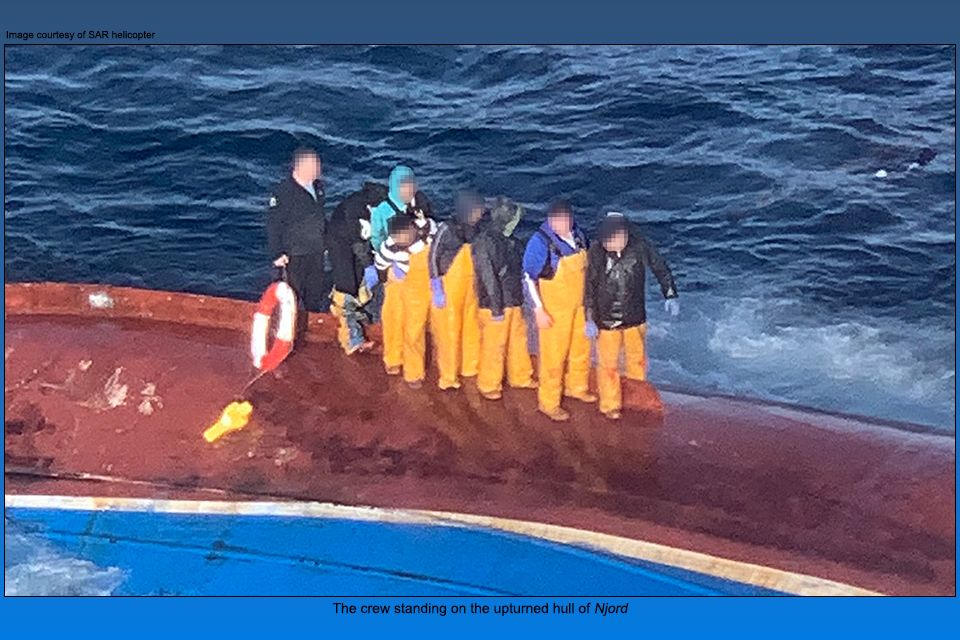Safety flyer to the fishing industry - Njord
Published 13 February 2025
1. Summary
The capsize and foundering of the fishing vessel Njord (SH 90), resulting in one fatality, 150 miles north-east of Peterhead, Scotland, on 6 March 2022

2. Narrative
On 6 March 2022, the 26.56m stern trawler Njord (SH 90) capsized and foundered 150 miles north-east of Peterhead, Scotland while processing a very large haul of fish. The MAIB investigation found that the weight of catch, which was secured to the starboard trawl winch and acting on a handrail high up on the vessel’s starboard side, caused it to list to starboard to an angle where downflooding occurred. A drain valve had been left open in the starboard weathertight bulkhead on the vessel’s working deck, which allowed downflooding into Njord’s internal spaces. The starboard list subsequently increased further, resulting in the capsize of the vessel.
Njord’s eight crew abandoned to the vessel’s upturned hull, but none were wearing either a personal flotation device, an immersion suit or carrying a means to raise an alert. Fortunately, Njord‘s Emergency Position Indicating Radio Beacon floated free of the wreck and alerted search and rescue (SAR) authorities, which tasked a helicopter and a nearby vessel to assist. The SAR helicopter arrived on scene 45 minutes later but Njord sank within minutes of its arrival and all eight crew ended up in the water. Neither of Njord‘s liferafts surfaced and it is likely that these were trapped on board and then lost their buoyancy. Three of the crew were rescued by the SAR helicopter, but one of them drowned despite the efforts of the helicopter’s on board medic. The remaining five crew were rescued by the nearby vessel’s fast rescue craft.
The MAIB investigation determined that the modifications made to Njord in 2021 reduced the safety margin of the vessel’s transverse stability. The Maritime and Coastguard Agency (MCA) was not formally informed of these modifications, nor were any calculations completed by a naval architect to assess the impact of the modifications on the vessel’s stability.
The combination of a reduced margin of stability due to the modifications and the vessel’s operational conditions during the incident directly contributed to Njord’s capsize.
3. Safety lessons
-
Fishermen are reminded that the MCA must be informed of any significant changes or modifications to a fishing vessel. Early engagement with a naval architect is essential to maintain safe margins of stability.
-
The consequences of operating a vessel outside the assumptions made in its stability book can be unpredictable and devastating. A trim and stability book includes the operating assumptions against which likely stability conditions have been calculated and fishing vessel owners and skippers must work within these to maintain the safe operation of their vessels and prevent accidents.
-
When things go wrong, smooth abandonment and rescue relies on serviceable equipment, knowledge, experience, training, and good communications. Training in the use of liferafts, EPIRBs, digital selective calling and issuing a “Mayday” is vital, as are frequent sea survival and man overboard drills.
-
Essential safety equipment needs to be accessible to save lives. Consider storing abandon ship lifejackets and immersion suits in a box on the working deck of your vessel to make certain they are within reach when there is no time to go below.
4. Further information
Our accident investigation report is available at: https://www.gov.uk/maib-reports/capsize-and-sinking-of-fishing-vessel-njord-with-loss-of-1-life
Extract from The United Kingdom Merchant Shipping (Accident Reporting and Investigation) Regulations 2012 – Regulation 5:
The sole objective of the investigation of an accident under the Merchant Shipping (Accident Reporting and Investigation) Regulations 2012 shall be the prevention of future accidents through the ascertainment of its causes and circumstances. It shall not be the purpose of an such investigation to determine liability nor, except so far as is necessary to achieve its objective, to apportion blame.
Note:
This safety flyer is not written with litigation in mind and, pursuant to Regulation 14(14) of the Merchant Shipping (Accident Reporting and Investigation) Regulations 2012, shall be inadmissible in any judicial proceedings whose purpose, or one of whose purposes is to attribute or apportion liability or blame.
Marine Accident Investigation Branch
First Floor, Spring Place
105 Commercial Road
Southampton
SO15 1GH
Email iso@maib.gov.uk
Enquiries during office hours +44 (0)23 8039 5500

